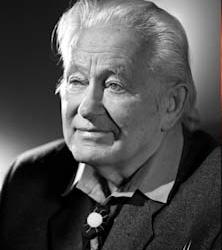
Georges Charpak (1924-2010), portrait photographed by Studio Harcourt Paris, Spatulli, CC BY 3.0 , via Wikimedia Commons
On August 1, 1924, French physicist and Nobel Laureate Georges Charpak was born. Charpak was awarded the Nobel Prize for Physics in 1992 for his invention and development of subatomic particle detectors, in particular the multiwire proportional chamber, a breakthrough in the technique for exploring the innermost parts of matter.
“If there’s one thing to do, it’s to engage in education.” George Charpak
Youth in the French Resistance and Detention
Georges Charpak was born Jerzy Charpak to Jewish parents, Anna (Szapiro) and Maurice Charpak, in the village of Dąbrowica in Poland (now Dubrovytsia in Ukraine). Charpak’s family moved from Poland to Paris when he was seven years old, beginning his study of mathematics in 1941 at the Lycée Saint Louis. By the age of 15 he was an anti-fascist militant, and after the Germans occupied Paris he managed to obtain papers for the entire family, which would give them all a French identity if the need arose. Nevertheless, the family fled south to the unoccupied Vichy zone, where Charpak was able, for a while, to continue his studies at the Lycée Joffre in Montpellier.[3] In 1943, he joined a Communist Resistance group but was imprisoned by Vichy authorities. Charpak spent a year in prison in France before being transported to the Nazi concentration camp at Dachau, where he remained until the camp was liberated in 1945. He returned to France, becoming a French citizen in 1946.
A PhD in Nuclear Physics
After classes préparatoires studies at Lycée Saint-Louis in Paris and later at Lycée Joffre in Montpellier, Charpak joined in 1945 the Paris-based École des Mines, one of the most prestigious engineering schools in France. The following year he became a naturalized French citizen. He graduated in 1948, earning the French degree of Civil Engineer of Mines becoming a pupil in the laboratory of Frédéric Joliot-Curie at the Collège de France during 1949, the year after Curie had directed construction of the first atomic pile within France.[5] While at the Collège, Charpak secured a research position for the National Centre for Scientific Research (CNRS). He received his PhD in 1954 from Nuclear Physics at the Collège de France, receiving the qualification after having written a thesis on the subject of very low radiation due to disintegration of nuclei.

Cut-away showing interior of a drift chamber
The Multiwire Proportional Chamber
In 1959, he joined the staff of CERN (European Organization for Nuclear Research) in Geneva as one of the first physicists there, where he should stay until his retirement in 1991 [4]. This is where he invented, and developed, the multiwire proportional chamber. The chamber was patented and that quickly superseded the old bubble chambers, allowing for better data processing. The multiwire proportional chamber is a type of proportional counter that detects charged particles and photons and can give positional information on their trajectory, by tracking the trails of gaseous ionization. uses an array of wires at high voltage (anode), which run through a chamber with conductive walls held at ground potential (cathode). The chamber is filled with carefully chosen gas, such as an argon/methane mix, such that any ionizing particle that passes through the tube will ionize surrounding gaseous atoms. The resulting ions and electrons are accelerated by the electric field across the chamber, causing a localised cascade of ionization known as a Townsend avalanche. This collects on the nearest wire and results in a charge proportional to the ionisation effect of the detected particle. By computing pulses from all the wires, the particle trajectory can be found. This new creation had been made public during 1968. Charpak was later to become a joint inventor with Nlolc and Policarpo of the scintillation drift chamber during the latter parts of the 1970s.
The Nobel Prize in Physics
In 1980, Georges Charpak became professor-in-residence at École supérieure de physique et de chimie industrielles in Paris (ESPCI) and held the Joliot-Curie Chair there in 1984. This is where he developed and demonstrated the powerful applications of the particle detectors he invented, most notably for enabling better health diagnostics. He was elected to the French Academy of Sciences in 1985. Georges Charpak was awarded the Nobel Prize in Physics in 1992 “for his invention and development of particle detectors, in particular the multiwire proportional chamber“, with affiliations to both École supérieure de physique et de chimie industrielles (ESPCI) and CERN. This was the last time a single person was awarded the physics prize, as of 2015. Charpak used his status as a Nobel laureate to campaign on many political and social causes; he combined a fervent belief in the benefits of nuclear power with an equally strong commitment to nuclear disarmament.[4]
George Chaprak passed away on September 29, 2010, aged 86.
Nuclear Detectors – Ionization Chamber & Proportional Counter, [7]
References and Further Reading:
- [1] Frank Close, Georges Charpak obituary, The Guardian, October 7, 2010.
- [2] Douglas Martin, Georges Charpak, Physics Nobel Winner, Dies at 86, The New York Times, Oct 2, 2010.
- [3] George Charpak, Obituary, The Telegraph
- [4] CERN and its Brilliant Minds, SciHi Blog, June 10, 2013.
- [5] Irène Joliot-Curie and Artificial Radioactivity, SciHi Blog
- [6] Georges Chaprak at Wikidata
- [7] Nuclear Detectors – Ionization Chamber & Proportional Counter, For the Love of Physics @ youtube
- [8] Giomataris, I. (2010). “Georges Charpak (1924–2010)”. Nature. 467 (7319): 1048.
- [9] Giomataris, Ioannis (December 2010). “Georges Charpak-a true man of science”. CERN Courier. 50 (10): 33–36.
- [10] Timeline for Georges Chaprak, via Wikidata






Pingback: Whewell’s Gazette: Year 03, Vol. #51 | Whewell's Ghost